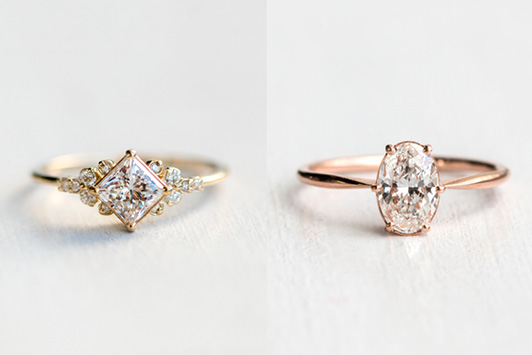
The number-one battle in selling fine jewelry online is conveying the quality,” says Melanie Casey, owner of Melanie Casey Fine Jewelry in North Andover, Massachusetts. “I needed a website that would communicate that you can trust us to buy your engagement ring,” she says, describing her overarching goal in revamping her website.
Casey, who began her career in finance, had always designed jewelry inspired by form, symmetry and patterns. But after the 2008 recession, she became “obsessed’’ with turning her hobby into a full-time profession. And while her self-created website “looked pretty enough,” it didn’t present the professional face of a luxury jewelry designer. In 2017, she engaged Cake & Arrow, a New York-based customer-experience agency, to create a site that shows “we deliver.”
“I wanted people to understand as soon as they got to our home page, who we are, what we are about, how small we are and how much care we put into the product,” Casey explains. She sells almost all of her jewelry online to an international clientele; her studio is only open to the public once a month, on Saturdays.
Creating the look and feel
Given that engagement rings represent the majority of her business, Casey wanted a light and airy — “bridalesque” — color palette to create that emotional context for the user. But the jewelry takes center stage. “More than anything else, I wanted to feature the jewelry as soon as you land on the page,” she emphasizes, noting that most of the pages show the jewelry displayed on a hand.
Realistically depicting the size was also important to Casey. “We tried really hard not to exaggerate the size,” she says. “What you’re getting is exactly as described. I wanted to be up-front and clear that I will do the best I can with your dollar. It’s all about trust.”
Casey also insisted that her 11 staff members have their own faces on the site to highlight that they are a small and collaborative team dedicated to the client. However, while the site had to be easy to navigate, she concentrated more on photography than technology. After conducting her own research, Casey selected Shopify Plus, largely because it would create a seamless buying experience. “I didn’t want a cart that was glitchy or took too long to load or would time out,” she explains.
Focus on social media
Rather than emphasizing search engine optimization (SEO), Casey focuses on social media, citing Instagram and Pinterest as her key targets. Again, honesty is the driving force. “SEO can make you sound like a robot. If we don’t speak the same way on the site as we do on the phone or in the studio, [customers will] think we’re different people,” she stresses.
Business has been “pretty incredible” since the site launched in January, approximately six months after the initial work began. Metrics from February through April, compared to the same period in 2017, have been impressive: Transactions have nearly doubled, and revenue is up 111%.
“I always tell my clients that they should know that I won’t sell a diamond that I wouldn’t wear myself,” says Casey. “And that’s the same message on my website.”
melaniecasey.com
Image (left to right): Stargaze diamond engagement ring; Wishing Well oval-cut diamond ring.Article from the Rapaport Magazine - June 2018. To subscribe click here.